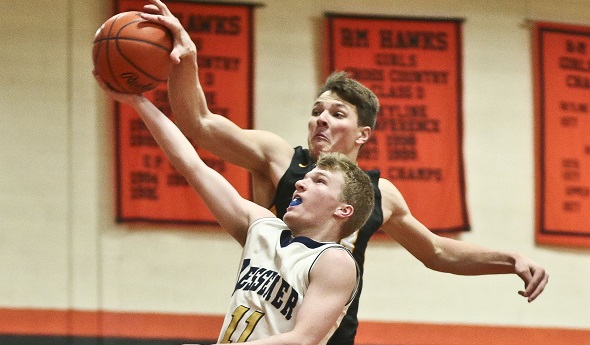
Jake Witt: the UP's Best-Kept Secret
December 22, 2017
By Dennis Grall
Special for Second Half
ESCANABA – You would think it difficult to be a 6-foot-7 athlete and weigh 235 pounds and not be known outside your home area.
 It can happen. And it did happen.
It can happen. And it did happen.
Jake Witt has basically flown beneath the radar of high school sports aficionados heading into the final months of his high school career. That despite the fact he is perhaps the premier senior athlete in Michigan's Upper Peninsula and among the best in the state.
The Ewen-Trout Creek senior has scored more than 1,000 points and is close to 1,000 rebounds in basketball. He is a two-time 8-player all-state football selection, earning those honors after the only two seasons he played football.
He lives about 10 miles from tiny Ewen, where E-TC is located on M-28 about 55 miles from the peninsula's western border with Wisconsin. His school has fewer than 100 students and plays basketball against mostly similar-sized schools from its side of the U.P.
Only a handful of colleges even knew about him, in either sport, primarily because of location and the fact he did not participate in the travel ball circuit. Michigan Tech University, about 70 miles north of his home, knew all about him and offered him a basketball scholarship. Witt signed his letter of intent this fall.
Northern Michigan University, about 110 miles east in Marquette, was in football contact with him before basketball got on board. NMU's basketball team was Witt's second choice behind Tech, where he had participated in some team camps.
Wisconsin-Green Bay was the lone Division I school on his trail, although Northwestern University showed some initial interest. Ferris State and Grand Valley State – which play in the Great Lakes Intercollegiate Athletic Conference with Tech and NMU – also were interested.
"It was nice not having as much attention and having a low profile," Witt said a day after the Panthers beat Bessemer 63-59 last week to raise their record to 4-0 this season. "It was nice playing on a team that does not have much hype. I can just go out and play."
Despite the low profile, it is surprising he escaped notice on the recruiting trail. After all, how many players his size run the 40-yard dash in 4.8 seconds, are used as the primary ball handler on the press break, shoot 3-point field goals with 50 percent accuracy and dominate inside despite constant double- and triple-team defenses?
"He is a big-time athlete, a big-time performer in the U.P.," said veteran Tech coach Kevin Luke. "He is bigger, faster and stronger than anybody up here."
With that pedigree, it is surprising Witt escaped attention of the major schools, although the U.P. is far from even the outlying recruiting paths and not known as a breeding ground for high-caliber cagers – and Witt has not played in Lower Michigan or Wisconsin.
"If he played just one summer of AAU ball (or played downstate) he would have had a ton of Division I schools after him," said E-TC coach Brad Besonen, adding "his location and not advertising himself" were factors in his lack of attention.
Witt had an opportunity to join a travel team in Escanaba, but declined because of six-hour round-trip drives for practice on Wednesday and Sunday nights in addition to lengthy travel for games. "It was mainly my location," he said of avoiding travel teams.
The colleges that did not chase Witt may have missed someone who could be a big contributor.
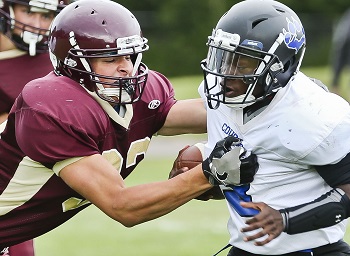 "We rely on him for everything," said Besonen, citing his protection of the basket that includes blocking shots and/or forcing shot adjustments, ball-handling and floor-wide scoring skill. "He is very agile, has great feet and excellent body control."
"We rely on him for everything," said Besonen, citing his protection of the basket that includes blocking shots and/or forcing shot adjustments, ball-handling and floor-wide scoring skill. "He is very agile, has great feet and excellent body control."
Besonen said Witt's lack of "advertising himself" is because of strong family ties, which also were a factor in his decision to stay within about five hours of home. "He likes to hang out with his family (and friends), bass fish and weight lift.
"He is a total throw-back kid from 30-40 years ago," said Besonen. "He is definitely not a look-at-me-guy."
As a powerful presence, Witt draws major defensive attention – and through his unselfishness, he has developed into an excellent passer. "Our biggest problem is not being able to take him out for a lot of rest. He has a big frame, and he gets gassed. We don't play slow," said Besonen.
This season Witt is averaging 33 points and 14 rebounds a game. In football, where E-TC students played for Ontonagon in a co-op arrangement, 13 of his 28 pass receptions in a run-oriented offense were touchdowns, and he covered about 600 yards. Last year at E-TC, he set an MHSAA 8-player record with 25 TD catches while nabbing 71 passes for 1,698 yards.
Playing college football was considered, but he had 12 years of basketball experience. With only two years of gridiron experience and at the 8-player level, he probably would have been a football red-shirt and may have bulked up to play tackle, although his desire was to be a tight end and catch passes.
Tech gained his scholarship signature because of its splendid academic reputation.
"After college and entering the work force, the degree you get up there (in Houghton) is worth so much," said Witt, who is still pondering his academic direction.
"I am definitely excited to finish my senior year with my college decision already made," he added, noting that he is looking forward to working with Tech assistant coach Josh Buettner, a former GLIAC all-star for the Huskies. "Josh is one of the best big-men coaches in the GLIAC, and Coach Luke is also a very good coach."
Witt, who is a good fit for the blue-collar Tech brand of basketball, will likely play a 3-4 spot with the ability to venture outside to force mismatch situations. "We feel like we are getting a good ball player, a great blue-chipper," said Luke.
After towering over his prep opponents, Witt knows it will be an adjustment to battle players of equal size or bigger when he gets to Tech. "It will take a lot of getting used to playing bigger guys," he said, expecting to get more one-on-one opportunities than in high school.
Besonen firmly believes Witt will adjust the college level. "They could benefit from him being there right now. Add another year and offseason conditioning, and he could be helpful next year," said Besonen.
"He is still building (his game). The adjustment level will be huge for him, especially at his position," Besonen added, noting Witt must improve his footwork. "His feet are coordinated and quick."
Witt may be virtually unknown now. But clearly, he has the potential to become well known.
 Denny Grall retired in 2012 after 39 years at the Escanaba Daily Press and four at the Green Bay Press-Gazette, plus 15 months for WLST radio in Escanaba; he served as the Daily Press sports editor from 1970-80 and again from 1984-2012. Grall was inducted into the Upper Peninsula Sports Hall of Fame in 2002 and serves as its executive secretary. E-mail him at [email protected] with story ideas for the Upper Peninsula.
Denny Grall retired in 2012 after 39 years at the Escanaba Daily Press and four at the Green Bay Press-Gazette, plus 15 months for WLST radio in Escanaba; he served as the Daily Press sports editor from 1970-80 and again from 1984-2012. Grall was inducted into the Upper Peninsula Sports Hall of Fame in 2002 and serves as its executive secretary. E-mail him at [email protected] with story ideas for the Upper Peninsula.
PHOTOS: (Top) Jake Witt blocks a shot during his team's win earlier this month against Bessemer. (Middle) Witt, left, playing for the Ontonagon/Ewen-Trout Creek football co-op team, wraps up an Eben Junction Superior Central ball carrier this fall. (Photos courtesy of the Ironwood Daily Globe.)
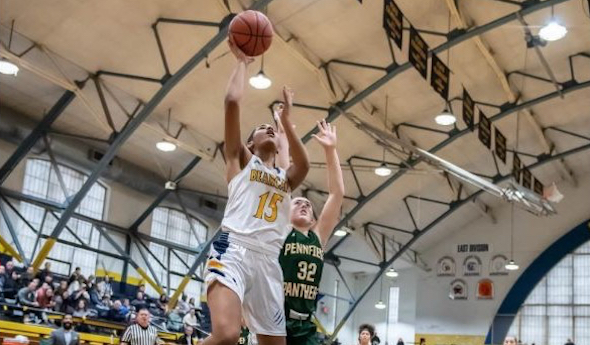
Hoops Finds Annual Home During Holidays
December 27, 2019
By Ron Pesch
Special for Second Half
Nothing says the Holidays like a high school basketball tournament.
It started, like many things do, with a drip. Well, make that a dribble.
The Michigan High School Athletic Association has allowed Holiday basketball tournaments for years. When was the first? That’s hard to establish. No one really kept track of such. A 1934 Wakefield News article indicates that a “Christmas Tournament will be held for the (Gogebic) Range teams at Wakefield December 27 and at Ironwood December 28.” Hurley, Bessemer, Ironwood and Wakefield were entered in the “blind” tournament, with opponents drawn just before game time. It was a new idea, at least in the Upper Peninsula.
“Nothing of its kind has ever been attempted in the Peninsula before,” stated the Ironwood Daily Globe. The tournament, won by Hurley, was a financial success. After expenditures, including the purchase of trophies, profit equaled enough that $22.42 was distributed to each school competing in the tournament. Plans were announced to bring back the tournament in a larger format the following year. It did return the following December, with the same teams in the same format but with all games played in Wakefield. This time out, Ironwood topped Hurley 22-21 for the tournament title.
In the Lower Peninsula in 1935, an All-Berrien County Holiday tournament was held Dec. 26, 27 and 28, with Three Oaks winning the Class B-C division title, 15-13 in the final over Berrien Springs. St. Joseph Catholic emerged as the Class D victor with a surprising 27-26 win over the reigning MHSAA state champ from Stevensville. The 14-team competition was played at Niles High School. Attendance was “slim, very slim” for the opening day of the tourney. The event did not return in 1936.
A similar, but much smaller, event was staged in Berrien County in 1941 with the Bridgman Class C Invitational. The tournament featured seven teams with contests spread over three nights. It was a success.
“Some 450 paid admissions were checked in Wednesday night for the championship finals, which Bridgman won from Berrien Springs. … The total paid admission for the three night event was 1,420 fans with a gross gate of approximately $400.”
By the mid-1940s, the idea of playing prep basketball during the Christmas lull had begun to take off across the state.
In December 1946, before a crowd of 1,500 at the Flint IMA Auditorium, Holland, the reigning Class A champion, downed Flint Northern 51-48 behind a pair of late field goals by Ken ‘Fuzz’ Bauman in the first annual Motor City Invitational. In Jackson, Detroit Catholic Central won the Michigan Catholic Invitational, beating Kalamazoo St. Augustine, 42-40. Bridgman again snagged the title at the Sixth Annual Berrien Class C Christmas Holiday Tournament. It was the Bees’ third Christmas championship in four years. The Little Eight Conference Holiday Tournament was played across four school gymnasiums as the calendar transitioned from 1946 to 1947. Bangor downed Covert, 34-29, in the championship contest hosted at Watervliet High School on Saturday, Jan. 4.
“Holiday tournament basketball has really caught on in Michigan,” said Hal Schram in the Detroit Free Press in 1947. “There will be no Christmas-New Year’s rest for at least 60 Michigan high school squads which have jumped at the chance to sharpen their collective shooting eyes for the long season ahead. … At last count, tournaments will be played between Dec 17 and Jan 3 at Flint, Saginaw, Grand Rapids, Jackson, Lincoln Park, Fremont, Negaunee, Marquette, Benton Harbor and Detroit.”
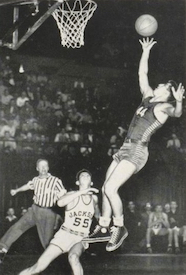 The same eight schools that played at the first Motor City tournament – Jackson, Grand Rapids Central, Holland, Muskegon Heights, Monroe, Midland, Flint Central and Flint Northern – were invited back for the second year. According to Schram, “Not a single participating school of a year ago wanted to be left out.”
The same eight schools that played at the first Motor City tournament – Jackson, Grand Rapids Central, Holland, Muskegon Heights, Monroe, Midland, Flint Central and Flint Northern – were invited back for the second year. According to Schram, “Not a single participating school of a year ago wanted to be left out.”
Jackson downed Flint Northern in the title game, 39-34.
The Saginaw Invitational, hosted at Arthur Hill High School, boasted six Class A schools as well as Alma and Mount Pleasant, both Class B schools. Mount Pleasant surprised the field, winning the tournament with a 40-25 triumph over Dearborn Fordson in the championship game.
A year later in December, Schram wrote, “The Michigan High School Athletic Association wasn’t caught unaware when the tournament bug started to bite every sector of the state.”
“Never did we expect such a wave of tournament play as we will see during the next three weeks,” said Charles Forsythe, state director for the MHSAA, noting 34 Christmas vacation tournaments were scheduled between December 15 and January 8 during the 1948-49 basketball season. “Perhaps we’re lucky at that. The Oklahoma association has had to sanction 123 tournaments.”
Forsythe and Schram explained the reasons for the wave of popularity. Of particular interest was the fact that, at the time, a school sponsoring both football and basketball could play a total of no more than 24 games, combined, in the two sports. However, MHSAA rules allowed a basketball team the chance to play as many as three games during a Holiday tournament and be charged with only one of its allotted combination of 24 contests. (The MHSAA rules changed prior to 1972-73 to allow basketball teams a maximum of 20 games.)
Coaches could keep their squads sharp during the two-week layoff with games rather than just mandatory practices. And, as a bonus to all because tournaments were financed through gate admissions, invitations to larger tournaments meant teams got to “stay and eat at the best hostelries, go on sightseeing tours when not playing and play non-conference opponents from other sections of the state.“
Add in the chance to play before larger-than-normal crowds, and the formula for a successful tournament was cast.
Beginning with the 1950-51 season, the football-basketball rule was altered to count play in mid-season invitational tournaments as two contests. With the change, according to the Detroit Times, “the number of such meets dropped sharply.”
Only nine Holiday tournaments, involving 50-plus teams, were recorded by the MHSAA during the 1951-52 season: the 5th annual Flint Parochial Invitational, the Alpena Catholic Invitational (involving 16 teams), the 5th Annual Greater Lansing Invitational, the Albion College Invitational, the Twin-Five Conference Christmas Tournament (a 10-team replacement for the disbanded Little Eight Conference’s tournament), the Otisville Invitational, the Columbiaville Invitational and the 1st Annual Portland St. Patrick Christmas Invitational.
But by the 1960s, Holiday Tournaments were again regaining popularity, with more now focused on teams from a specific community or section of the state, especially among smaller schools.
The St. Patrick tournament was still going strong in 1966 – its 15th year – with an eight-team, four-day design. Williamston downed a Cinderella squad from Carson City, 64-44, before 1,100 fans at Portland to earn the championship. Other Mid-Michigan holiday tournaments played out in Chelsea and Swartz Creek at the same time.
The Flint Parochial League Tournament was a mainstay of the Holiday season until the breakup of the league in the early 1970s.
“Basketball tournaments have become popular around the state and nation in recent years,” wrote Wendy Foltz, longtime Battle Creek Enquirer sports editor, before the kickoff of the inaugural Battle Creek Central Holiday Cage Tournament in 1968. In a twist that harkened back to earlier days, the eight-team event represented nearly every section of lower Michigan. “Battle Creek never has been a rabid basketball town like some around the state,” added a hesitant Foltz, noting a hope that the event could at least break even.
Hosted at the Cereal City’s historic Fieldhouse, built in 1928, that first tournament was won by host Battle Creek Central, which downed Traverse City 71-53 before a crowd of 2,000. Phil Todd led the Bearcats with 29 points, including 21 in the first half, while 6-foot-8 Tom Kozelko paced TC with 24. Muskegon Heights won the consolation game, holding off a late Ypsilanti Willow Run rally, 78-77. Other schools competing were Battle Creek Lakeview, Grand Blanc, Romulus and recently-opened Jackson Lumen Christi.
Chuck Turner, Central’s head coach, and junior varsity coach Jack Schils had contacted 60 schools during the summer of 1967 to organize the 12-game schedule.
“The response was terrific,” said Schils, who added, “Many schools could not accept because of schedule commitments but want to enter a year hence.”
The Battle Creek tournament was back in 1969, again hosting teams from near and far. Schils noted that cost ran high when teams were brought in from long distances: “However, this type of tournament is highly desirable so we hope fans will support it.”
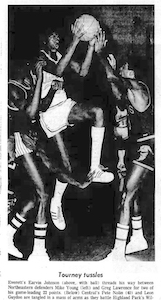
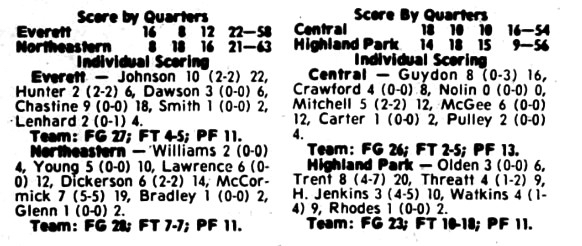 But the event was discontinued following the 1970-71 season when the “eight team format became too unwieldy,” according to the Enquirer “… and both crowd and the quality of play declined.”
But the event was discontinued following the 1970-71 season when the “eight team format became too unwieldy,” according to the Enquirer “… and both crowd and the quality of play declined.”
Pared down to a four-team format, it returned in a big way in December 1975. The tournament saw standing-room-only crowds of more than 3,000 for games between Battle Creek Central, Detroit Northeastern, Class A quarterfinalist Lansing Everett and reigning Class A champion Highland Park.
Detroit Northeastern downed Lansing Everett, 63-58 for the Cereal City championship trophy. Everett junior Earvin Johnson scored 22 points and, with teammate Reggie Chastine, was named to the all-tournament team along with Northwestern’s Wilbert McCormick, the tourney MVP, and his teammate Greg Lawrence. Highland Park’s William Trent and Battle Creek Central’s Leon Guydon also were named to the team.
By the 1980s, it seemed that the Christmas break nearly mimicked March in Michigan.
“I think a Christmas tournament really helps your program,” said Turner in 1980 to the Enquirer. He had taken over the head coaching position at Battle Creek in the fall of 1967 after a successful stint at Willow Run. “I don’t understand basketball teams having a preseason, playing three or four games, then taking two weeks off. When you get back, it’s like starting over.”
Besides Turner’s squad, the 1980 field included Detroit Western, Detroit Murray Wright and eventual winner Kalamazoo Central. The event would ultimately be re-christened the Battle Creek Central Chuck Turner Holiday Classic.
“The late Chuck Turner started bringing big games to the city over the holidays when he first started at the school in the 1960s,” wrote Bill Broderick in the Enquirer in 2018.
“Chuck started this because he wanted to give people the chance to come back home for the holidays and see everyone play. It’s been like a family reunion over the years,” Fred Jones told Broderick. Jones was a longtime assistant to Turner. “That we can keep it going in his name is great and hopefully we can keep if going for another 50 years.”
The girls are now part of the action. All five Battle Creek city schools – Central, Pennfield, Harper Creek, Lakeview, and St. Philip – were part of the event in 2018.
This year the Chuck Turner Central Field House Holiday Classic will again span two days – December 27 and 28 – and will again see all five city schools play on the historic floor.
Other Holiday tournaments scheduled this year include:
Petoskey Invitational – December 13-14
Raider Shootout – December 21
18th Annual Muskegon Area Sports Hall of Fame Classic – December 27
Earl McKee Classic – December 27-28
North Farmington Holiday Extravaganza – December 27
Motor City Roundball Classic – December 27
Cornerstone Invitational – December 27
Washtenaw Hoops Showcase – December 28
 Ron Pesch has taken an active role in researching the history of MHSAA events since 1985 and began writing for MHSAA Finals programs in 1986, adding additional features and "flashbacks" in 1992. He inherited the title of MHSAA historian from the late Dick Kishpaugh following the 1993-94 school year, and resides in Muskegon. Contact him at [email protected] with ideas for historical articles.
Ron Pesch has taken an active role in researching the history of MHSAA events since 1985 and began writing for MHSAA Finals programs in 1986, adding additional features and "flashbacks" in 1992. He inherited the title of MHSAA historian from the late Dick Kishpaugh following the 1993-94 school year, and resides in Muskegon. Contact him at [email protected] with ideas for historical articles.
PHOTOS: (Top) The Battle Creek Central and Pennfield girls face off during the 50th Chuck Turner Classic. (Middle) Shaheen Shaheen scores two points for Flint Northern, which fell to Jackson 39-34 during the 1947 Motor City championship game. (Below left) Lansing Everett’s Earvin Johnson makes a move toward the basket against Detroit Northeastern during the 1975 Battle Creek event. (Below right) Box scores from the 1975 tournament include Johnson’s 22 points in the 63-58 loss. Photos courtesy of the Battle Creek Enquirer, Lansing State Journal and Ron Pesch archives.)

